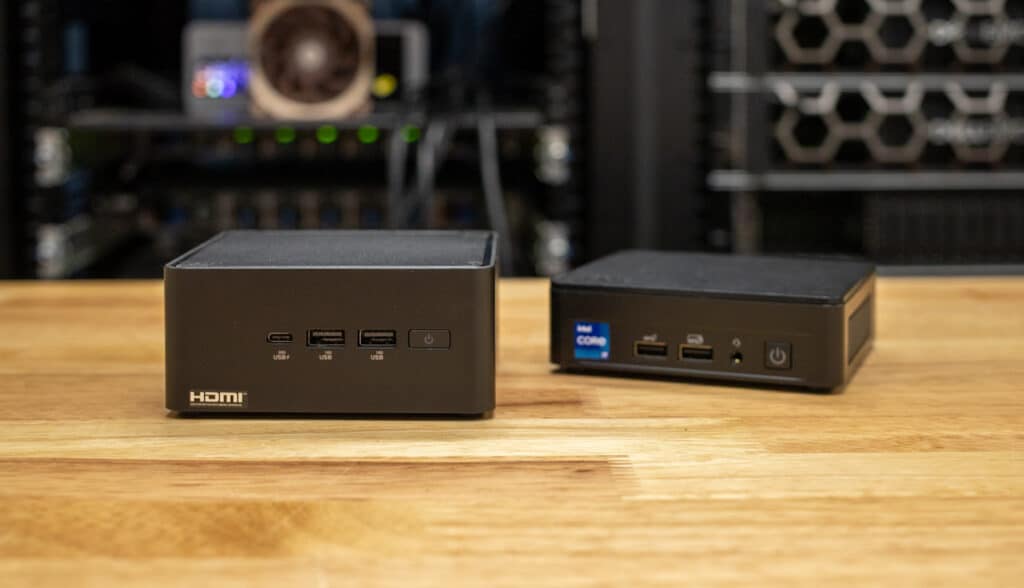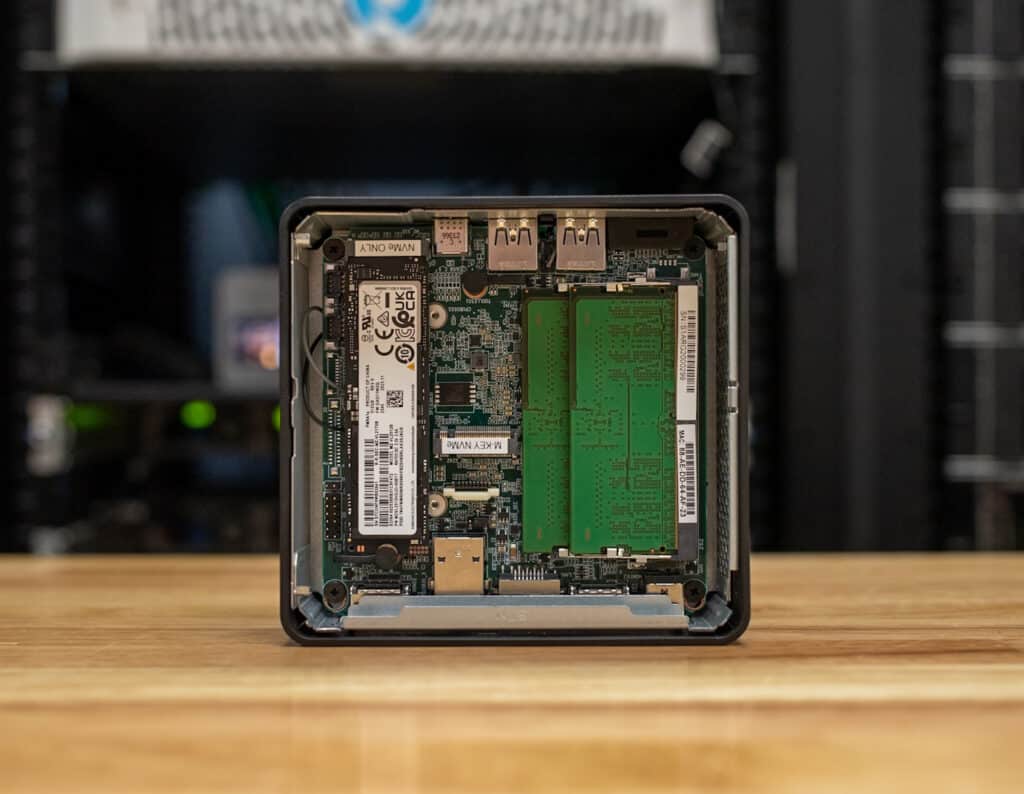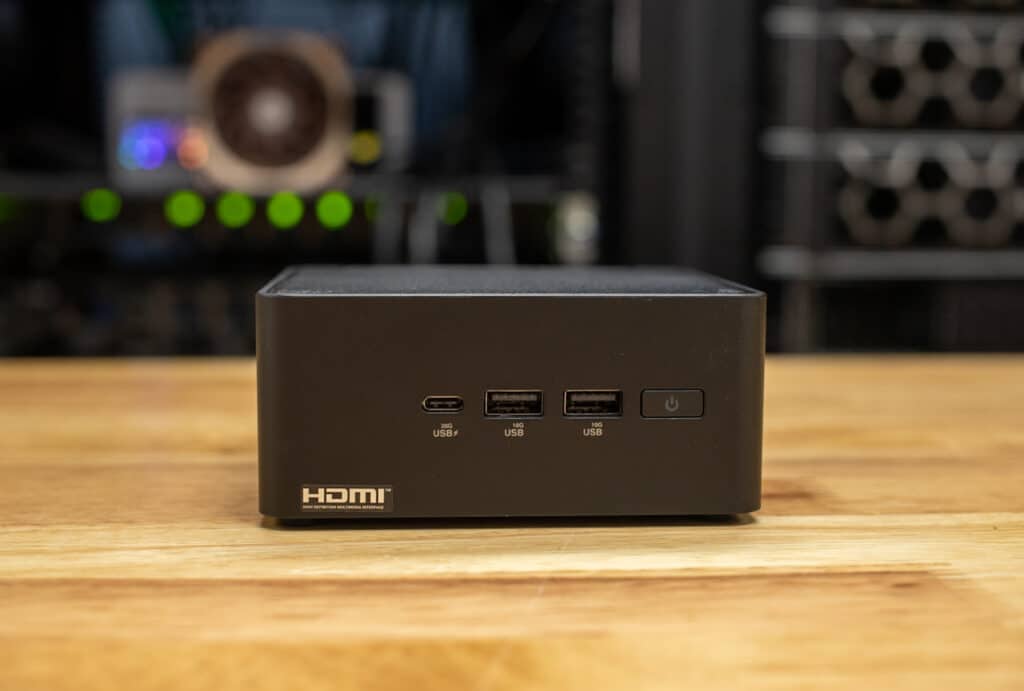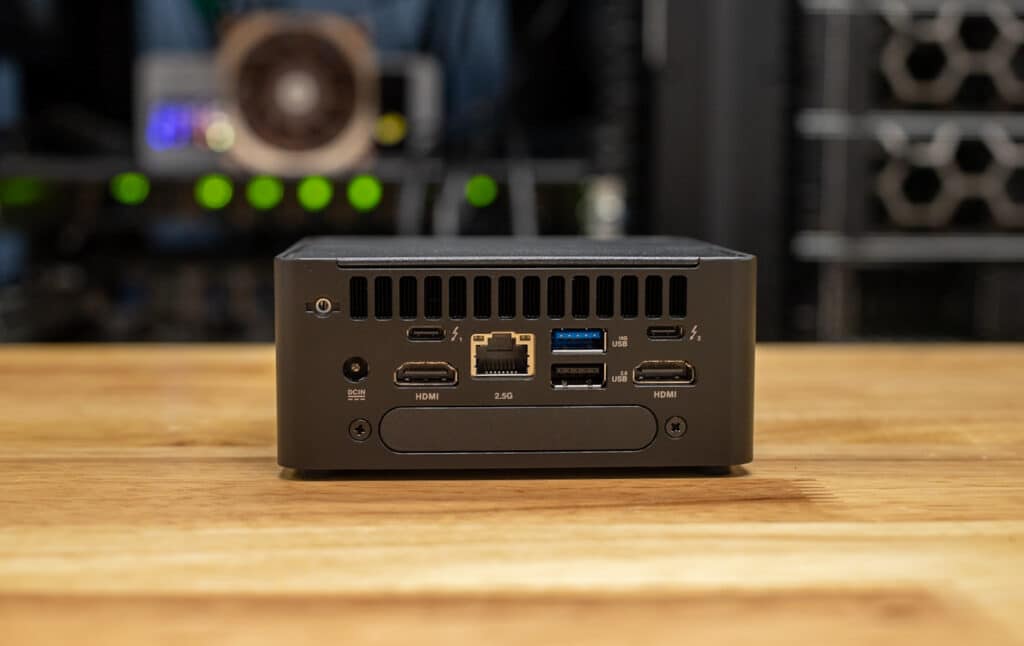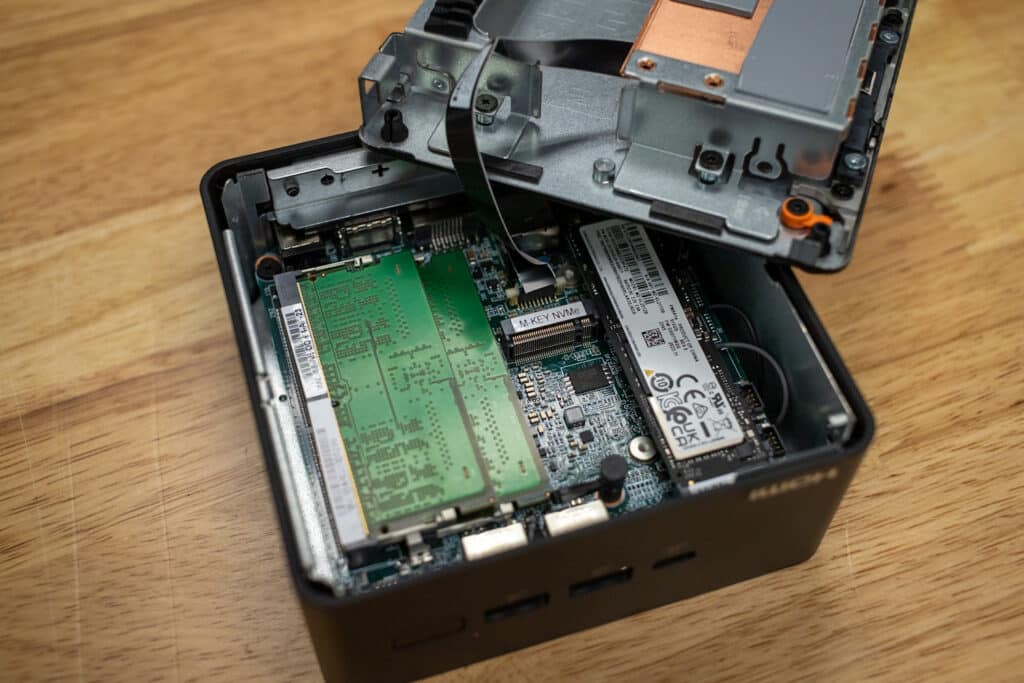The ASUS NUC 14 Pro is the first NUC released under ASUS’s leadership after acquiring the NUC product line from Intel.
The ASUS NUC 14 Pro represents the first NUC device released by ASUS since acquiring the business from Intel. It allows them to leverage their high-performance, compact computing expertise into the established and popular NUC platform. Built around Intel’s latest Ultra processor line, this mini-PC introduces enhancements in hardware and manageability over its predecessor, making it ideal for secure and reliable deployments in various environments — all within a form factor that occupies less than one liter of space.
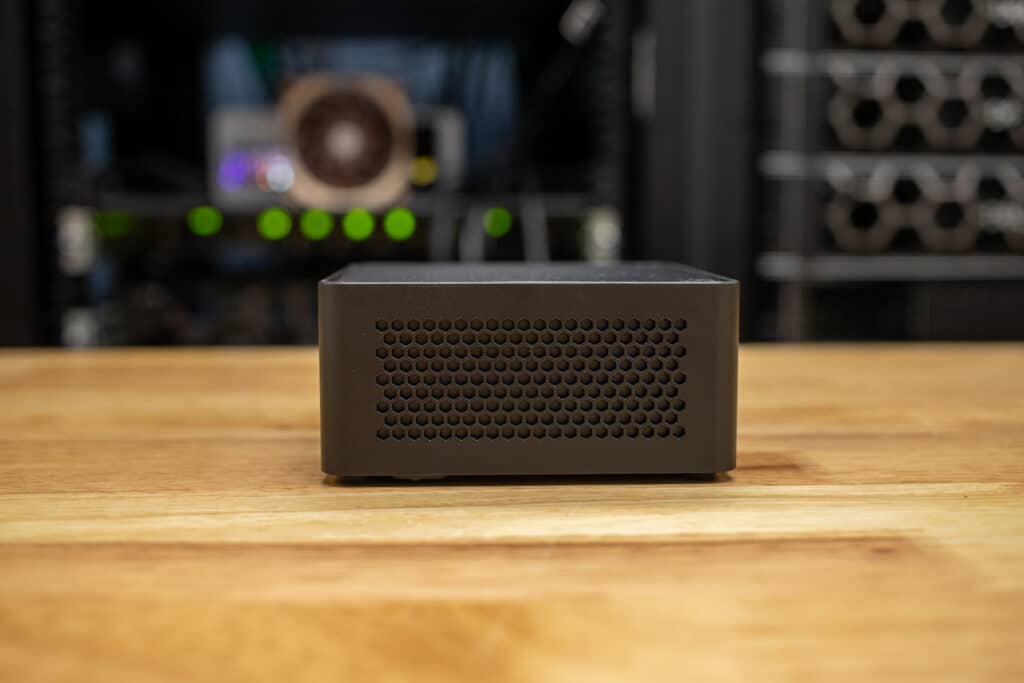
ASUS NUC 14 Pro Powered by Intel Ultra Processors
The ASUS NUC 14 Pro is available in both ‘Slim’ and ‘Tall’ models, and we opted for the tall version. The Ultra processors, part of the Meteor Lake family, power its performance. These processors are designed specifically for ultrabooks and compact PCs, and they excel in demanding workloads such as AI tasks and multimedia processing. They are commonly used in devices that balance power and efficiency within a compact form factor.
The Ultra 7 and Ultra 5 models come equipped with Intel Arc integrated graphics, enhancing their ability to handle demanding graphical tasks like 3D rendering, video editing, and casual gaming. However, NUCs’ compact size can constrict their performance, limiting cooling efficiency and sustained performance under heavy loads.
These processors are supported by Intel AI Boost, a feature that leverages a dedicated Neural Processing Unit (NPU) to accelerate AI workloads. This makes the NUC 14 Pro particularly good at handling tasks that involve machine learning, data analysis, or real-time AI processing.
The Intel Core Ultra 7 165H Processor is a high-performance version designed for demanding workloads. Its superior processing power and multi-core capabilities make it ideal for professional applications. Slightly more economical yet still powerful, the Core Ultra 7 155H Processor delivers robust performance for users needing high efficiency in multitasking environments.
For mid-range performance, the Core Ultra 5 135H and 125H Processors offer a balanced combination of speed and power efficiency, suitable for everyday computing tasks and moderate workloads. At the more economical end, the Core 3 100U Processor delivers essential performance with lower power consumption, making it an excellent choice for basic computing needs.
| ASUS NUC 14 Pro Specifications | |
| Model | NUC14RVK (Slim Chassis), NUC14RVH (Tall Chassis) |
| OS Support | Microsoft Windows 11 |
| CPU | Intel Core Ultra 7 165H, Ultra 7 155H, Ultra 5 135H, Ultra 5 125H, Core 3 100U |
| Chipset | Integrated |
| Graphics | Intel Arc GPU (U7/U5), Intel Graphics (i3) |
| Memory | 2 x SO-DIMM, Up to DDR5 5600 8GB~96GB |
| Storage | 1 x M.2 2280 PCIe Gen4x4 NVMe SSD Slot, 1 x M.2 2242 PCIe x4 NVMe SSD Slot (Tall model includes 1 x 2.5in SATA support) |
| Wireless Network | Intel Wi-Fi 6E AX211 2×2 and Bluetooth 5.3 |
| LAN | 2.5G Ethernet 10/100/1000/2500 Mbps |
| Front I/O | 1 x USB 3.2 Gen2x2 Type C, 2 x USB 3.2 Gen2 Type A |
| Side I/O | 1 x Kensington Lock |
| Rear I/O | 2 x Thunderbolt 4 Type-C Ports, 1 x USB 3.2 Gen 2 Type-A, 1 x 2.0 Type-A, 2 x HDMI 2.1 (TMDS) ports, 1 x RJ45 LAN Port, 1 x DC-in |
| Power Supply | 120W Power Adapter (U5/U7), 90W Power Adapter (C3) |
| Dimension | 117mm x 112mm x 37mm (Slim), 117mm x 112mm x 54mm (Tall) |
| Weight | 600g (Slim), 750g (Tall) |
| Accessories | AC Adapter + Power Cord, Warranty Card, Quick Start Guide, VESA Mount Plate |
The NUC 14 Pro is also optimized for multitasking when configured on higher-end builds, thanks to its support for up to 96GB of DDR5 memory. This is particularly useful when running multiple applications simultaneously or working with large datasets—more on this in the performance section below.
The storage configuration includes an M.2 PCIe Gen4x4 NVMe SSD onboard slot, while the ‘Tall’ chassis model consists of an additional 2.5-inch SATA bay for expanded storage capabilities.
ASUS NUC 14 Pro Features and Use Cases
Just by looking at it, the ASUS NUC 14 Pro seems like a highly adaptable device, capable of fitting into a range of use cases where space is at a premium. For example, it can simultaneously support up to four 4K displays while neatly tucked away. It is an excellent choice for environments requiring extensive visual real estate, such as digital signage, financial trading desks, or video production studios. This capability is highlighted by its I/O-heavy build, which includes Thunderbolt 4 / USB4 Type-C ports and HDMI 2.1 ports, ensuring that users can connect multiple high-resolution monitors without compromising performance or quality.
The NUC 14 Pro is tailored for enterprise users and tech enthusiasts who require a versatile and reliable computing solution in space-constrained settings such as small offices, home workstations, and industrial environments. It can be placed anywhere in our lab or office without affecting our real estate.
For businesses, Intel vPro Enterprise offers a reasonably substantial advantage. This technology enhances security and provides comprehensive manageability features, such as remote recovery and system health monitoring, crucial for maintaining a reliable IT infrastructure. For example, Intel One-Click Recovery allows IT administrators to initiate an OS rebuild remotely, minimizing downtime and reducing the need for on-site technical support. The NUC 14 Pro also features Intel Platform Service Record, which tracks the health and usage of the device throughout its lifecycle, aiding in timely upgrades and repurposing.
In addition to its enterprise features, the NUC 14 Pro is equipped with intelligent Wi-Fi sensing, which optimizes power efficiency by automatically locking or waking the device based on user proximity. Coupled with certified Bluetooth connectivity, this feature makes the NUC 14 Pro ideal for various applications, from corporate environments where security and manageability are vital to creative studios where performance and display versatility are critical. Home office environments requiring a compact (yet decently powerful) computing solution will also find much to like here.
ASUS NUC 14 Pro Design and Build
The ASUS NUC 14 Pro’s design combines a compact form factor with solid build quality. Its chassis is made from durable materials, so it can withstand the rigors of daily use while maintaining a sleek and professional appearance. As we indicated above, the NUC is available in two sizes, the latter of which we are looking at today: the Slim model, which is more suited for space-constrained environments, and the tall model, which offers the additional 2.5-inch HDD option for more storage.
The front panel features a USB 3.2 Gen2x2 Type-C port and two USB 3.2 Gen2 Type-A ports alongside the power button—a very nice, minimalistic look.
The rear panel is equipped with two Thunderbolt 4 / USB4 Type-C ports, capable of supporting dual 4K displays or a single 8K display, making it a versatile hub for high-resolution output. The rear panel includes an RJ45 LAN port for wired network connections, two HDMI 2.1 ports for display options, and two more USB ports to accommodate other external devices.
To open the chassis, remove the screws at the bottom and slide off the cover, exposing the internal components. The internal design of the NUC 14 Pro is very compact, though very modular for ease of maintenance. Its layout allows easy access to the RAM slots, M.2 SSD slot, and SATA slot for quick upgrades or replacements.
ASUS NUC 14 Pro also has a fan profile feature with both a Standard and Quiet mode. This allows it to operate at maximum speed when processing heavy tasks, with the ability to switch to a lower speed (below 31 dB) when a quieter working environment is needed.
ASUS NUC 14 Pro Performance
Our ASUS NUC 14 Pro review unit has the following specifications:
- Intel Core Ultra 7 165H
- 16GB DDR5 5600
- 500GB Samsung PM9A1a SSD
- Intel Arc Graphics
- Windows 11 64-bit (10.0.22631)
The barebones model (no RAM or hard drives) with the Intel Core Ultra 7 165H processor costs roughly $1,000.
In our benchmarking comparison, we evaluated the performance of the ASUS NUC 14 Pro against the previous generation NUC 13 Pro. The NUC 13 Pro features an Intel Core i7-1360P processor, 32GB of DDR4 3200 memory, and the same 500GB Samsung PM9A1a SSD. While the small amount of RAM affects which benchmarks the NUC 14 can run, this comparison will highlight the advancements in processing power and memory speed capabilities that ASUS has integrated into the NUC 14 Pro and how these improvements translate into real-world performance across various applications.
SPECworkstation 3
SPECworkstation3 specializes in benchmarks designed to test all key aspects of workstation performance. It uses over 30 workloads to test CPU, graphics, I/O, and memory bandwidth. The workloads fall into broader categories such as Media and Entertainment, Financial Services, Product Development, Energy, Life Sciences, and General Operations. We will list the broad-category results for each instead of the individual workloads. The results are an average of all the individual workloads in each category.
The ASUS NUC 14 Pro outperformed the NUC 13 Pro across most SPECworkstation 3 categories, with notable improvements in Media and Entertainment, Product Development, Life Sciences, Financial Services, and Energy workloads. The NUC 14 Pro’s gains, mainly in Financial Services, highlight the benefits of the upgraded Intel Ultra 7 165H processor and DDR5 memory. However, the NUC 13 Pro slightly surpassed in General Operations, indicating that the older model still holds some advantages in everyday office productivity tasks.
| SPECworkstation 3 (Higher is better) |
ASUS NUC 14 Pro (Intel Ultra 7 165H, 16GB DDR5 5600) | ASUS NUC 13 Pro (Intel i7-1360P, 32GB DDR4 3200) |
| Media and Entertainment | 2.26 | 2.09 |
| Product Development | 2.51 | 2.16 |
| Life Sciences | 2.36 | 2.13 |
| Financial Services | 3.66 | 2.78 |
| Energy | 2.8 | 2.34 |
| General Operations | 2.58 | 2.85 |
| GPU Compute | N/A | N/A |
Luxmark
Another 3D benchmark we run is LuxMark, an OpenCL GPU benchmarking utility.
Here, the ASUS NUC 14 Pro scored 2,033 in the Hallbench test and 789 in the Food test. These results are solid for a mini PC with an integrated GPU, meaning it will perform adequately in GPU-intensive tasks. However, these results are decent for a compact form factor like the NUC, but they will lag behind more powerful systems with dedicated GPUs or higher-end integrated graphics solutions.
| Luxmark (Higher is better) | ASUS NUC 14 Pro (Intel Ultra 7 165H, 16GB DDR5 5600) | ASUS NUC 13 Pro (Intel i7-1360P, 32GB DDR4 3200) |
| Hallbench | 2,033 | N/A |
| food | 789 | N/A |
UL Procyon AI Inference
UL’s Procyon estimates a workstation’s performance for professional apps. We ran the test on each system, once on the CPU and once on the GPU, with TensorRT.
Here, tests revealed mixed performance for the ASUS NUC 14 Pro. In MobileNet V3 and DeepLab V3, the NUC 14 Pro outperformed with significantly faster inference times (1.33ms and 41.74ms, respectively), indicating better optimization in these models compared to the NUC 13 Pro. However, in some tests like YOLO V3 and Real-ESRGAN, the NUC 13 Pro performed better, suggesting that specific AI workloads may benefit from the more significant memory (32GB DDR4) and slightly different architecture of the NUC 13 Pro.
| UL Procyon Average Inference Times (Lower is better) | ASUS NUC 14 Pro (Intel Ultra 7 165H, 16GB DDR5 5600) | ASUS NUC 13 Pro (Intel i7-1360P, 32GB DDR4 3200) |
| MobileNet V3 | 1.33ms | 6.73ms |
| ResNet 50 | 12.41ms | 11.74ms |
| Inception V4 | 38.15ms | 33.46ms |
| DeepLab V3 | 41.74ms | 72.88ms |
| YOLO V3 | 102.86ms | 61.66ms |
| Real-ESRGAN | 4,205.32ms | 2,587.07ms |
y-cruncher
y-cruncher is a multi-threaded and scalable program that computes Pi and other mathematical constants to trillions of digits. Since its inception in 2009, it has become a popular benchmarking and stress-testing tool for overclockers and hardware enthusiasts. The program’s ability to utilize all available CPU threads makes it an excellent test of processing power and system stability. In our ASUS NUC 14 Pro tests, we encountered limitations due to the system’s 16GB of RAM, which was insufficient for completing larger computations that require more memory.
In the y-cruncher benchmark, the ASUS NUC 14 Pro completed the 1 billion digits computation in 38.375 seconds, compared to the NUC 13 Pro’s 51.281 seconds. However, regarding the 2.5 billion and 5 billion digits tests, the NUC 14 Pro failed to complete these computations due to insufficient RAM. At the same time, the NUC 13 Pro finished these tests in 150.580 seconds and 341.215 seconds, respectively. In a separate test using version 0.8.9.5 of y-cruncher, the NUC 14 Pro completed the 1 billion digits computation in 38.686 seconds, slightly slower than its previous result, with the NUC 13 Pro taking 48.836 seconds. The RAM limitations again prevented the NUC 14 Pro from completing the 2.5 billion and 5 billion digits tests, while the NUC 13 Pro recorded times of 148.456 seconds and 340.857 seconds, respectively, showing consistent performance across different benchmark versions.
These results indicate that while the ASUS NUC 14 Pro performs exceptionally well with smaller datasets, its 16GB of RAM becomes a limiting factor for more memory-intensive computations. For users requiring extensive computational power, upgrading to a configuration with more RAM would be necessary to utilize y-cruncher’s capabilities fully.
| y-cruncher (Total Computation time) |
ASUS NUC 14 Pro (Intel Ultra 7 165H, 16GB DDR5 5600) | ASUS NUC 13 Pro (Intel i7-1360P, 32GB DDR4 3200) |
| 1 billion digits | 38.375 seconds | 51.281 seconds |
| 2.5 billion | N/A | 150.580 seconds |
| 5 billion | N/A | 341.215 seconds |
| y-cruncher (Total Computation time) (0.8.9.5) |
||
| 1 billion digits | 38.686 seconds | 48.836 seconds |
| 2.5 billion | N/A | 148.456 seconds |
| 5 billion | N/A | 340.857 seconds |
Blender OptiX
Blender OptiX is an open-source 3D modeling application. This benchmark was run using the Blender Benchmark CLI utility. The score is samples per minute, with higher being better.
The ASUS NUC 14 Pro outperformed the NUC 13 Pro across all tested scenes. For the ‘Monster’ scene, the NUC 14 Pro achieved 105.061 samples per minute, compared to the NUC 13 Pro’s 81.940. In the ‘Junkshop’ scene, the NUC 14 Pro recorded 69.350 samples per minute, well ahead of the NUC 13 Pro’s 49.911. In the ‘Classroom’ scene, the NUC 14 Pro produced 49.893 samples per minute, surpassing the NUC 13 Pro’s 33.966. These results highlight the superior rendering capabilities of the NUC 14 Pro (likely driven by its Intel Ultra 7 165H processor and faster DDR5 memory), making it a better choice for 3D modeling and rendering tasks.
| Blender 42 CPU Samples Per Minute (Higher is Better) | ASUS NUC 14 Pro (Intel Ultra 7 165H, 16GB DDR5 5600) | ASUS NUC 13 Pro (Intel i7-1360P, 32GB DDR4 3200) |
| Monster | 105.061 | 81.940 |
| Junkshop | 69.350 | 49.911 |
| Classroom | 49.893 | 33.966 |
Geekbench 6
Geekbench 6 is a cross-platform benchmark that measures overall system performance. You can find comparisons to any system you want in the Geekbench Browser. We also only have comparable numbers for the Precision 5690 in this test.
The NUC 14 Pro scored slightly lower in the CPU Single-Core test, with a score of 2,480, compared to the NUC 13 Pro’s 2,617. However, the NUC 14 Pro showed better in the CPU Multi-Core test with 11,959 than the NUC 13 Pro’s 11,269, indicating better performance in multi-threaded tasks. Most notably, the NUC 14 Pro outperformed the NUC 13 Pro, scoring 33,758 versus 16,389, showcasing its superior graphics capabilities for workloads that leverage the Arc GPU.
| Geekbench 6 (Higher is better) | ASUS NUC 14 Pro (Intel Ultra 7 165H, 16GB DDR5 5600) | ASUS NUC 13 Pro (Intel i7-1360P, 32GB DDR4 3200) |
| CPU Single-Core | 2,480 | 2,617 |
| CPU Multi-Core | 11,959 | 11,269 |
| GPU (Arc integrated GPU) | 33,758 | 16,389 |
7-Zip Compression
Our next test is the built-in memory benchmark in the popular 7-Zip utility. This benchmark measures the system’s ability to compress and decompress files, providing insight into CPU performance and memory bandwidth under typical compression workloads.
Unfortunately, limited RAM prevented the NUC 14 Pro from completing the 7-Zip compression test, so we only have results for the NUC 13 Pro. As indicated in the y-cruncher benchmark, this underscores the importance of sufficient RAM for memory-intensive tasks like compression, notably when dealing with large datasets.
| 7-Zip Compression Benchmark (Higher is better) | ASUS NUC 14 Pro (Intel Ultra 7 165H, 16GB DDR5 5600) | ASUS NUC 13 Pro (Intel i7-1360P, 32GB DDR4 3200) |
| Current CPU Usage | DNF | 679% |
| Current Rating/Usage | DNF | 8.822 GIPS |
| Current Rating | DNF | 59.921 GIPS |
| Resulting CPU Usage | DNF | 690% |
| Resulting Rating/Usage | DNF | 8.651 GIPS |
| Resulting Rating | DNF | 59.362 GIPS |
| Decompressing | ||
| Current CPU Usage | DNF | 1542% |
| Current Rating/Usage | DNF | 4.785 GIPS |
| Current Rating | DNF | 73.787 GIPS |
| Resulting CPU Usage | DNF | 1534% |
| Resulting Rating/Usage | DNF | 4.881 GIPS |
| Resulting Rating | DNF | 74.860 GIPS |
| Total Rating | ||
| Total CPU Usage | DNF | 1112% |
| Total Rating/Usage | DNF | 6.766 GIPS |
| Total Rating | DNF | 67.111 GIPS |
Blackmagic RAW Speed Test
The Blackmagic RAW Speed Test performance benchmarking tool measures a system’s capabilities in handling video playback and editing using the Blackmagic RAW codec. It evaluates how well a system can decode and play back high-resolution video files, providing frame rates for both CPU- and GPU-based processing.
The NUC 14 Pro demonstrated solid performance with 56 FPS in the 8K CPU test, outperforming the NUC 13 Pro’s 46 FPS. In the 8K OpenCL test (which leverages GPU processing), the NUC 14 Pro led with 45 FPS compared to the NUC 13 Pro’s 29 FPS. These results demonstrate that it can handle demanding video tasks, especially for high-resolution video files with sufficient headroom for smooth playback and editing of 8K video.
| Blackmagic RAW (Higher is Better) | ASUS NUC 14 Pro (Intel Ultra 7 165H, 16GB DDR5 5600) | ASUS NUC 13 Pro (Intel i7-1360P, 32GB DDR4 3200) |
| 8K CPU | 56 FPS | 46 FPS |
| 8K OPENCL | 45 FPS | 29 FPS |
Blackmagic Disk Speed Test
We ran the popular Blackmagic Disk Speed Test against the system’s primary storage drive. Both NUCs are using a 500GB Samsung PM9A1a SSD. The two systems ‘ read and write speeds are similar, and they performed well for the mini-PC form factor. However, they don’t fully utilize the peak capabilities of Gen4 technology.
| Blackmagic DiskSpeed test (Higher is Better) | ASUS NUC 14 Pro (Intel Ultra 7 165H, 16GB DDR5 5600) | ASUS NUC 13 Pro (Intel i7-1360P, 32GB DDR4 3200) |
| Read | 4,521.9MB/s | 4,819.9MB/s |
| Write | 3,649.8MB/s | 3,669.8MB/s |
Cinebench R23
Cinebench R23 is a benchmark tool that evaluates a system’s CPU performance by rendering a complex 3D scene using the Cinema 4D engine.
In this benchmark, the NUC 14 Pro scored 16,655 points in the multi-core test, significantly outperforming the NUC 13 Pro, which scored 12,034 points. This makes the NUC 14 Pro well-suited for demanding tasks like 3D rendering, video encoding, and other computationally intensive workloads. However, in the single-core performance, the NUC 13 Pro slightly edges out the NUC 14 Pro, indicating that the NUC 13 Pro may perform better in applications that rely heavily on single-core speed, such as certain aspects of gaming or older software.
| Cinebench R23 (Higher is better) | ASUS NUC 14 Pro (Intel Ultra 7 165H, 16GB DDR5 5600) | ASUS NUC 13 Pro (Intel i7-1360P, 32GB DDR4 3200) |
| Multi-Core | 16,655 pts | 12,034 pts |
| Single-Core | 1,800 pts | 1,926 pts |
| MP ratio | 9.25 x | 6.25 x |
Cinebench 2024
Cinebench 2024 extends the benchmark capabilities of R23 by adding GPU performance evaluation.
In this version, the NUC 14 Pro maintained its advantage in multi-core tasks, scoring 901 points compared to the NUC 13 Pro’s 671 points. This further emphasizes the NUC 14 Pro’s capabilities in handling multi-threaded tasks efficiently. Although the NUC 13 Pro slightly leads in single-core tasks, the overall results suggest that the NUC 14 Pro is an improved option for professionals needing robust performance for rendering, content creation, and other heavy-duty applications.
| Cinebench R24 (Higher is better) | ASUS NUC 14 Pro (Intel Ultra 7 165H, 16GB DDR5 5600) | ASUS NUC 13 Pro (Intel i7-1360P, 32GB DDR4 3200) |
| Multi-Core | 901 pts | 671 pts |
| Single-Core | 105 pts | 113 pts |
| MP Ratio | 8.59 x | 5.95 pts |
Conclusion
The NUC 14 Pro is the first model released under ASUS’s leadership after acquiring the NUC product line from Intel, and it appears to be successful. This acquisition will allow them to leverage their compact, high-performance computing expertise while building on the established NUC platform. If the NUC 14 Pro is any indication, ASUS is positioned to enhance the NUC series with innovations, particularly in areas like AI and IoT, while continuing to support existing systems.
The tall NUC 14 Pro is an improved version of the famous mini-PC line, featuring a slightly larger chassis than its predecessor. This allows it to support a 2.5″ HDD in addition to its M.2 Gen4 slot, providing more storage options for users. Despite the increase in size, it maintains an ultra-compact form factor, offering both performance and storage in a small footprint. In our tests, the NUC 14 Pro showed strong performance, particularly excelling in multi-core tasks and outperforming its predecessor, the NUC 13 Pro, in most tests. For example, Cinebench R23 and R24 handled demanding workloads like 3D rendering and video editing exceptionally well, establishing itself as a capable successor.
Although there are limitations compared to traditional desktop systems, the NUC 14 Pro’s combination of the latest Intel processors, DDR5 memory, and ultra-compact design makes it a versatile and powerful choice for both professional and home use. The NUC 14 Pro continues the tradition of delivering impressive performance in a small footprint, now with ASUS driving future releases.
Engage with StorageReview
Newsletter | YouTube | Podcast iTunes/Spotify | Instagram | Twitter | TikTok | RSS Feed

